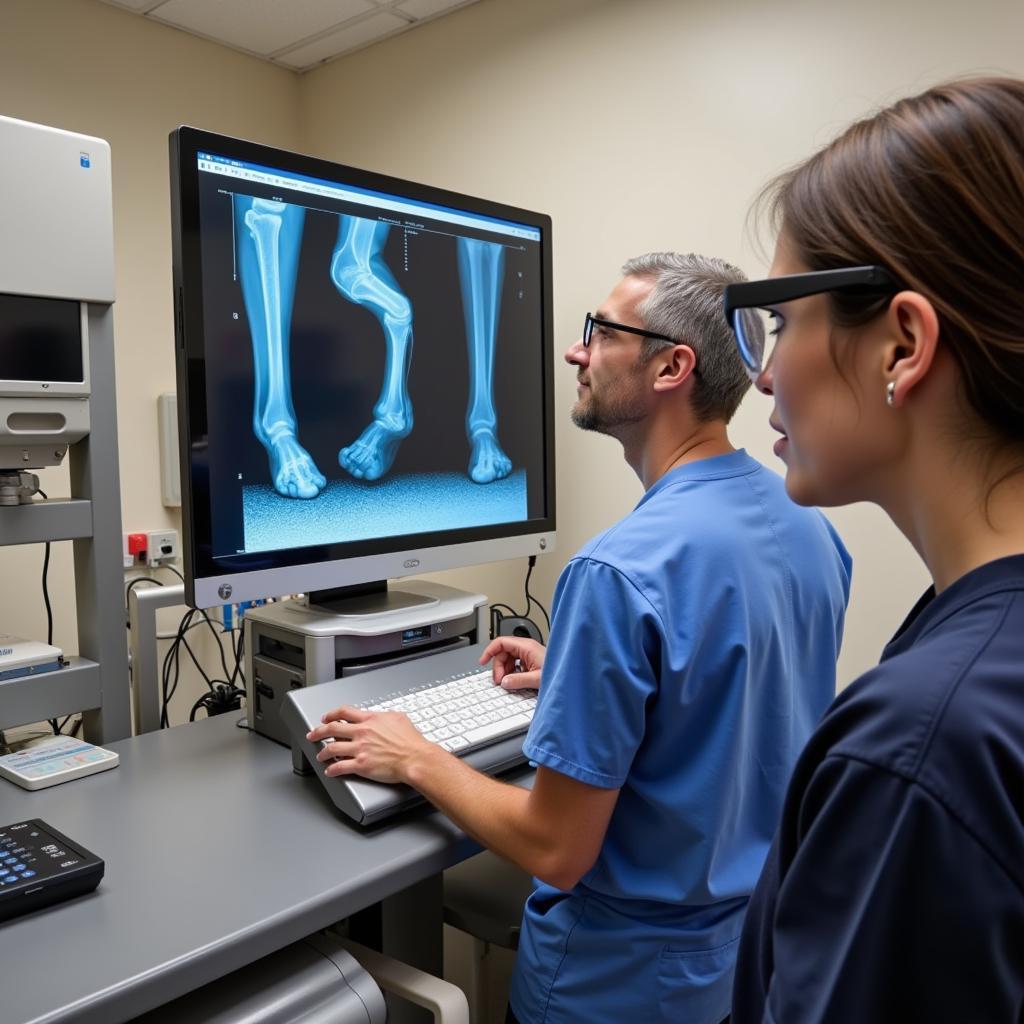Horse foot x-rays are essential diagnostic tools for equine veterinarians. They provide a detailed internal view of the hoof, allowing for the identification of a variety of conditions that may not be visible externally. From subtle fractures to chronic infections, x-rays play a crucial role in accurate diagnosis and effective treatment planning for your equine companion.
Decoding the Secrets of Horse Foot X-Rays
Horse foot x-rays are invaluable for diagnosing lameness and other hoof-related issues. But what exactly are we looking for in these images? A trained veterinarian analyzes various aspects, including bone density, joint alignment, and the presence of any foreign objects or abnormal growths. Understanding the basic principles of these x-rays can help horse owners appreciate the complexity of hoof health. Did you know that even minor changes in hoof balance can be detected through x-rays?
This guide will cover everything you need to know about horse foot x-rays, from the reasons why they are performed to what to expect during the procedure. We’ll delve into common conditions diagnosed through x-rays and discuss the various treatment options available. If you have a paint vs quarter horse, understanding their unique hoof care needs is even more important.
After a particularly exciting horse ride, it’s crucial to observe your horse for any signs of lameness. Early diagnosis and treatment can prevent minor hoof issues from escalating into more serious problems. Let’s delve deeper into the world of equine radiography. Knowing how to dispose of horse manure properly is also crucial for maintaining a healthy environment for your horse.
When are Horse Foot X-Rays Necessary?
So, when does your horse actually need a foot x-ray? Several common scenarios warrant this diagnostic procedure. Lameness, of course, is a primary reason. If your horse is exhibiting any signs of limping, discomfort, or changes in gait, an x-ray can pinpoint the source of the problem. Other situations include suspected fractures, abscesses, navicular disease, and laminitis. It’s also recommended for pre-purchase examinations to assess the overall health of a prospective horse’s hooves. Attending events like the Menlo horse show can also provide insights into various horse care practices.
 Horse Foot X-Ray Showing Lameness Diagnosis
Horse Foot X-Ray Showing Lameness Diagnosis
Persistent lameness is a significant indicator that an x-ray may be necessary. While some hoof problems can be treated with topical remedies, more complex issues require a thorough internal examination to determine the appropriate course of action.
The Horse Foot X-Ray Procedure: What to Expect
The horse foot x-ray procedure is generally straightforward. The horse’s hoof is typically cleaned and sometimes packed with a radiopaque putty to enhance the visibility of certain structures. The x-ray machine is then positioned to capture the desired images. The process is usually quick and painless, although sedation may be required for horses that are anxious or difficult to handle.
 Horse Foot X-Ray Procedure in a Veterinary Clinic
Horse Foot X-Ray Procedure in a Veterinary Clinic
If your horse is exhibiting signs of canker horse foot, x-rays are essential for determining the extent of the infection and guiding treatment.
Common Conditions Diagnosed Through Horse Foot X-Rays
Horse foot x-rays can reveal a wide range of conditions, from minor injuries to serious diseases. Some common diagnoses include fractures of the coffin bone, navicular bone changes, and signs of laminitis. Early detection through x-rays is vital for preventing long-term complications and promoting a successful recovery.
Conclusion
Horse foot x-rays are a critical tool for maintaining equine health. By providing a clear picture of the internal structures of the hoof, they empower veterinarians to make accurate diagnoses and develop effective treatment plans. From identifying subtle fractures to diagnosing complex conditions like navicular disease, horse foot x-rays play a vital role in ensuring the well-being of our equine partners.
FAQ
- How much does a horse foot x-ray cost? (Costs can vary depending on location and the complexity of the case).
- Are horse foot x-rays painful? (The procedure is typically painless, though sedation may be used for anxious horses).
- How long does it take to get horse foot x-ray results? (Results are usually available quickly, sometimes within the same day).
- What are the risks associated with horse foot x-rays? (Risks are minimal, mainly related to radiation exposure, which is kept to a safe level).
- How often should a horse have routine foot x-rays? (Routine x-rays are not typically recommended but are based on individual needs and risk factors).
- What are the signs that a horse needs a foot x-ray? (Lameness, heat in the hoof, swelling, and changes in gait are common indicators).
- Can horse foot x-rays be done at home? (Mobile veterinary services may offer x-rays on-site, but specialized equipment is required).
Scenarios requiring horse foot x-rays:
- Sudden onset lameness after a strenuous ride or a fall.
- Chronic lameness that hasn’t responded to other treatments.
- Swelling and heat in the hoof, indicative of an abscess.
- Changes in hoof shape or growth patterns.
- Pre-purchase examination to assess hoof health.
Further Reading:
- Check out our article on Paint vs Quarter Horse for breed-specific hoof care information.
- Learn about how to dispose of horse manure effectively.
- Read more about canker horse foot and its treatment.
- Find out about the Menlo horse show and equine events.
- Understanding an excited horse can help prevent injuries.
Contact Us
For any assistance or inquiries, please contact us:
Phone: 0772127271
Email: [email protected]
Address: QGM2+WX2, Vị Trung, Vị Thuỷ, Hậu Giang, Việt Nam
Our customer care team is available 24/7.